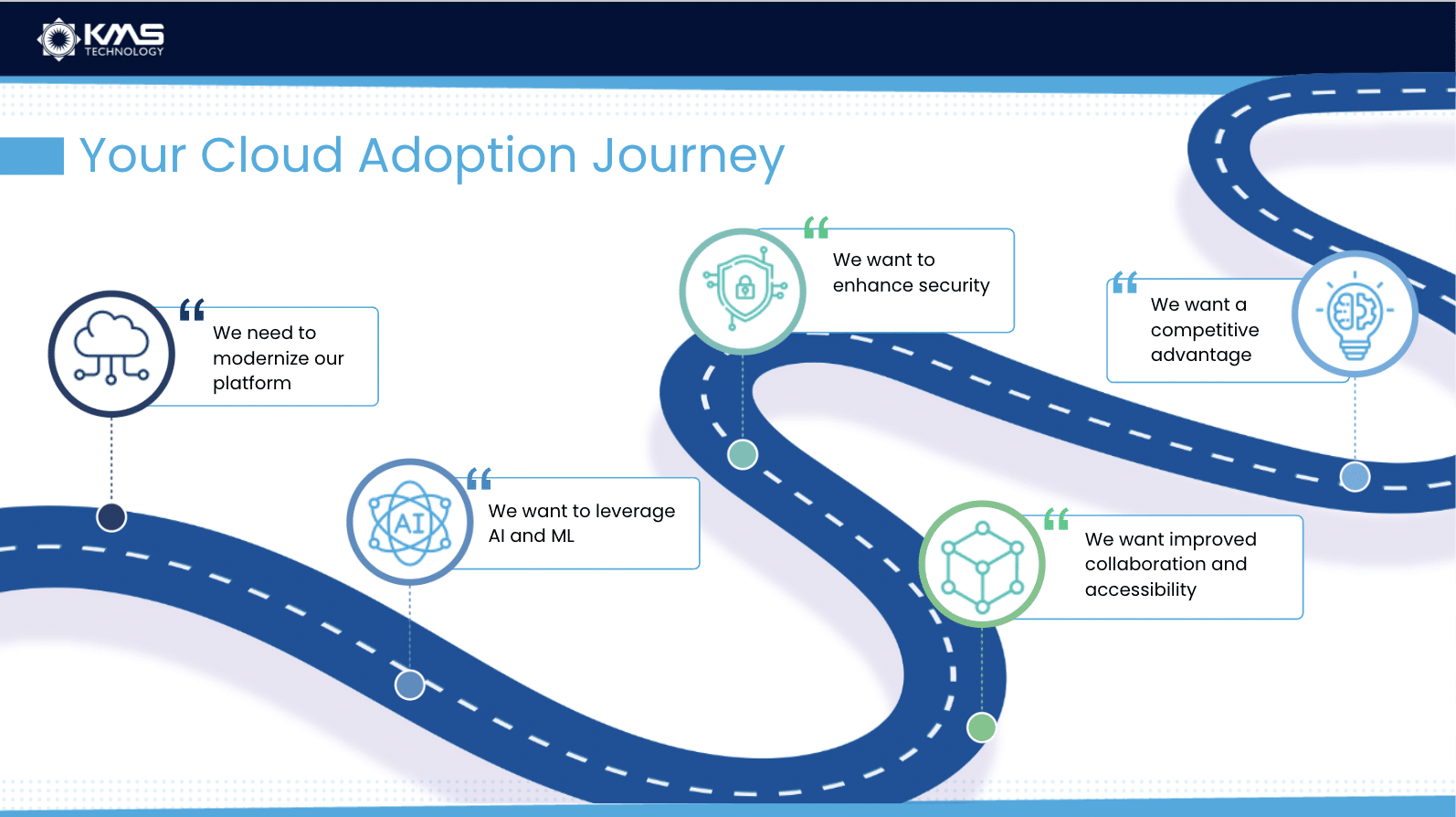Cloud Adoption Strategy: A No-Nonsense Approach for Your Business
Cloud adoption is no longer a question of “if” but “how.”
While moving to the cloud can provide immense benefits, businesses must approach the transition strategically to ensure they select the right solutions for their needs. This is the case whether you’re new to the cloud, switching providers, or looking to integrate or optimize your current cloud environment.
In this blog post, we break down key considerations for successful cloud adoption, featuring insights from Philip Massey, Director at Dean Dorton.
Listen to Massey’s So You Think You Can Dev? podcast episode, or read the key points below.
Define the “Why” Behind Your Cloud Adoption Strategy
Too often, companies rush into cloud adoption because it seems like the next logical step in digital transformation. However, adopting the cloud should be driven by a thorough understanding of your needs, not trends.
In other words, your cloud strategy is both a technical change and an aspect of your greater business strategy.
“You’re not just moving because your neighbor moved to the cloud or your competitor moved to the cloud. You’re moving because it’s what you need.”
Instead of focusing solely on cloud migration, businesses should first evaluate whether the transition will solve critical pain points.
Start by looking at your existing cloud platform or on-prem solution and identify what’s lacking. What do you want your cloud adoption journey to achieve? What are the benefits of a cloud migration for your company?
This is the North Star that should guide your cloud adoption strategy; do not get distracted by the cloud transformation of other organizations seeking different business outcomes.

Understand What Cloud Services Can and Cannot Do for You
Cloud-based solutions are not one-size-fits-all.
Businesses should carefully assess their needs rather than assume cloud-based solutions are inherently better than a hybrid cloud model or even on-premises data centers.
“Some of the biggest barriers to cloud adoption today are going to be understanding what is cloud and what is not.”
First, let’s start with how cloud migration can help businesses.
What Cloud Migration Can do For You
1. Scalability and Flexibility
- Cloud services allow businesses to scale resources up or down based on demand.
- Companies can quickly add new users, storage, or cloud computing power without investing in new hardware.
- Supports remote work and global operations with seamless access to applications and data.
2. Cost Optimization
- Reduces capital expenses on hardware, data centers, and IT infrastructure.
- Pay-as-you-go models ensure companies only pay for what they use.
- Lowers maintenance and operational costs since cloud providers handle updates and system management.
3. Enhanced Security and Compliance
- Leading cloud providers invest heavily in data security, offering encryption, multi-factor authentication, and automated threat detection.
- Many cloud solutions meet strict regulatory compliance standards (SOC 2, ISO 27001, HIPAA, GDPR).
- Cloud backup and disaster recovery reduce the risk of data loss.
4. Improved Collaboration and Accessibility
- Cloud-based applications allow teams to work together in real-time, regardless of location.
- Employees can securely access files, software, and tools from anywhere with an internet connection.
- Reduces version control issues by keeping documents and applications centralized.
5. Automatic Updates and Maintenance
- Software and infrastructure updates are managed by cloud providers, reducing downtime.
- Security patches are applied automatically, minimizing vulnerabilities.
- Eliminates the need for businesses to manually update and maintain on-premise servers.
6. Business Continuity and Disaster Recovery
- Cloud services provide built-in backup and recovery options to protect against data loss.
- Geographically distributed data centers ensure redundancy in case of outages or cyberattacks.
- Quick recovery times reduce the impact of disruptions on business operations.
7. Faster Deployment and Innovation
- Cloud platforms allow businesses to deploy applications and services faster than traditional IT infrastructure.
- Provides access to AI, machine learning, and big data analytics to drive innovation.
- Supports integration with third-party applications and APIs for enhanced functionality.
8. Competitive Advantage
- Companies that leverage cloud technology can react quickly to market changes.
- Enables businesses to experiment with new technologies, automate workflows, and optimize processes.
- Enhances customer experience with better reliability, speed, and service availability.
Now that said, a cloud migration does not guarantee these benefits. It depends on and effective cloud adoption strategy.
Let’s look at the other side of the coin so you can better tailor your cloud adoption plan:
Limitations of Cloud Adoption
1. Cloud Adoption Won’t Fix Bad Business Processes
- If your current processes are inefficient or outdated, moving them to the cloud won’t automatically improve them.
- Automation and scalability only work if your workflows are well-structured and optimized.
Example: A company with poor data management practices will still struggle in the cloud if data is disorganized or inconsistent.
2. Cloud Adoption Won’t Eliminate All IT Costs
- While cloud reduces capital expenditures on hardware, operational costs can still add up.
- Subscription-based pricing means ongoing expenses, and costs may increase as you scale.
Example: Companies often underestimate data transfer costs, storage fees, and additional charges for premium security features.
3. Cloud Infrastructure Won’t Guarantee 100% Uptime
- Even top-tier cloud providers experience outages, meaning some downtime is inevitable.
- While redundancy and failover mechanisms reduce risks, businesses should still have contingency plans.
Example: AWS, Microsoft Azure, and Google Cloud have all had major service disruptions, affecting companies worldwide.
4. Cloud Environment Won’t Automatically Secure Your Data
- Cloud providers offer robust security, but businesses are responsible for configuring settings correctly.
- Misconfigurations, weak passwords, and lack of internal security policies can lead to breaches.
Example: A misconfigured AWS S3 bucket left public can expose sensitive data, even if AWS itself is secure.
5. Cloud Adoption Framework Won’t Make Legacy Applications Instantly Compatible
- Not all legacy applications can transition smoothly to the cloud.
- Some older software requires significant modification or even replacement.
Example: A business using a 20-year-old on-premise ERP may need custom development or an entirely new cloud-native solution.
6. Cloud Deployment Won’t Solve Compliance and Regulatory Issues Automatically
- Moving to the cloud does not mean you are instantly compliant with regulations like GDPR, HIPAA, or SOC 2.
- Businesses must ensure proper configurations, access controls, and data handling policies align with compliance needs.
Example: A healthcare company using cloud storage must still implement encryption, access controls, and audit trails to comply with HIPAA.
7. Cloud Services Won’t Prevent Vendor Lock-In
- While cloud promotes flexibility, switching providers can be costly and complex.
- Businesses that rely on proprietary cloud services may struggle to migrate data or integrate with other platforms.
Example: A company deeply embedded in AWS services may find it difficult to move to Azure or Google Cloud due to platform-specific dependencies.
8. Cloud Adoption Won’t Magically Improve Performance
- Cloud computing can enhance performance, but if applications aren’t optimized, you may still experience latency or inefficiencies.
- Poorly designed applications may suffer from increased costs due to inefficient resource use.
Example: A company shifting an outdated database to the cloud without optimization may experience the same performance bottlenecks as before.
9. Cloud Infrastructure Won’t Work Well Without a Strong Internet Connection
- Cloud-based applications rely on internet connectivity, making them vulnerable to outages or slow speeds.
- Businesses in areas with unstable internet service may experience interruptions.
Example: A remote team using a cloud-based CRM may struggle if employees work in locations with limited bandwidth.
10. Cloud Won’t Eliminate the Need for IT Expertise
- While cloud providers handle infrastructure, companies still need IT professionals to manage configurations, security, and integrations.
- Skilled cloud architects and security specialists are crucial for a successful cloud strategy.
Example: A business that moves its data to the cloud but lacks internal IT expertise may misconfigure security settings, exposing data to risk
Define Your Cloud Adoption Strategy Criteria
To ensure a smooth cloud transition, organizations must create a clear set of requirements and use them as a guide when evaluating different cloud providers.
“Make your list of the features and functions that you need and things that you must have.”
This list should be referenced throughout the evaluation process to prevent getting distracted by unnecessary bells and whistles. Remember the business value at the core of your cloud adoption journey.
Additionally, consider your cloud readiness. Cost management will be critical, as monthly cloud costs can add up if you’re not prepared for them. That means your cloud strategy team should consider criteria based on a phased cloud adoption approach.
You do not have to take on all cloud technologies all at once for a successful cloud adoption.
Vet Cloud Providers for Security and Transparency
Security is a top concern when transitioning to the cloud. A reliable cloud service provider should be able to prove its commitment to security through audit reports and compliance documentation.
“One of the first things that you should do is talk to the vendor. Ask them for their audit reports, their SOC reports, their compliance reports—anything like that that’s applicable to you.”
Lack of transparency is a red flag. If a vendor cannot provide security details, it’s best to walk away.
“If they don’t, then that is a red flag that I would exclude from a search immediately because they are not taking those basic, generally accepted measures.”
Businesses should also ask about data ownership and what happens when they leave the platform:
“What happens with our data should we decide to leave the organization? When we move to another software, you will, of course, delete all of that, and how do we have verifiable knowledge that you have done that?”
Focus on Business Needs, Not Just Technology
Rather than being fixated on cloud adoption itself, organizations should evaluate how a solution fits within their existing business processes and projected cloud usage.
“Now we don’t talk really as much about cloud anymore. There’s that assumed underlying piece of it. Now we talk more about features. What can this do for my department? What can this do for my team members? How will this make their lives better?”
As such, cloud initiatives should be tied to clear business outcomes.
A cloud solution should be more than just a hosting option.
“A successful adoption, especially of a cloud-based product, can be something that really frees your business and allows you to not have to focus on your software, focus on your internal infrastructure, but really focus on your business.”
Future-Proof Your Cloud Adoption Strategy
Technology evolves rapidly, and organizations must choose a cloud adoption framework that adapts to their needs, and cloud services that support their long-term business goals.
A strong indicator of a vendor’s future-readiness is their approach to emerging technologies like AI and cloud computing.
“One of the really common things to look at right now in any software solution is ‘what are they doing with AI?’”
Your cloud adoption strategy should consider these current and future advances. Consider a cloud service provider’s history of innovative solutions. Are they at the forefront of new developments?
Do your cloud investments align with the larger direction of your industry and the emerging tech strategies of your organization?
Recognizing Green Flags and Red Flags in Your Cloud Adoption Strategy
When evaluating vendors in your cloud adoption plan, businesses should look for key indicators of trustworthiness and reliability:
✅ Green Flags
- Transparent about security practices
- Demonstrates a history of innovation
- Meets all business requirements
“Have they been first to market with things? Have they consistently lagged behind others in the adoption of processes, new technologies, new regulations in your industry?”
❌ Red Flags
- Unclear about security and compliance measures
- Lacks proof of uptime and service reliability
- Stagnant and slow to adapt to new technologies
“Maybe they’re not as transparent about their downtimes. Maybe they’re not as forthcoming with what the cloud can actually offer the companies that they’re talking to.”
Conclusion: Be Purposeful with Your Cloud Adoption Strategy
A cloud migration is a major decision that should be approached with careful planning and clear objectives. Organizations should focus less on the cloud itself and more on the broader impact on their business.
“Be purposeful with what you’re doing when it comes to cloud. Kind of take the cloud out of it—stop looking at the specific technology and look more at the big picture of what you’re trying to accomplish.”
By conducting thorough evaluations, maintaining clear business goals, and partnering with transparent, forward-thinking vendors, businesses can ensure a successful and sustainable cloud adoption.








